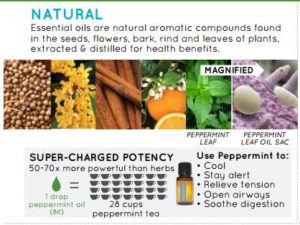Essential oils are volatile aromatic compounds found in plants. They are essentially the plants defense and offensive essence. Just like pests are repelled by Marigolds and thus protect the surrounding plants, essential oils can help our bodies. The molecules of Essential oils are so small they are easily absorbed into the body and then travel , with intelligence, to where they are needed to support health and wellness. Some are even capable of passing through the blood brain barrier.

Essential oils can be used 3 ways; aromatically by diffusing in a room or on the body for mood and emotional management, topically for locational discomfort, and internally to help cleanse the blood and support the organs of the body. Many oils may be used “neat” (without dilution)while others are recommended to be used with a carrier oil, such as, fractionated coconut oil, to avoid sensitivity to skin. ( “Hot” oils; oregano, thyme, cinnamon, cassia, lemongrass and more) One should never use water to wash off or dilute essential oils, as water acts as a driver, intensifying the absorption of essential oils. Common places for oil applications include the feet, wrists, back of neck and reflex points.
Due to the volatile nature of essential oils, it is important to note that they cannot remain in the body for an extended length of time , therefore, they are not addictive. If you want to learn more about essential oils and their usage, you may want to order a book called “Modern Essentials”. You may also access more information at aromaticscience.com and sourcetoyou.com. My favorite brand of essential oils is tested as Certified Pure Therapeutic Grade, which gives me great comfort for usage with all ages and members of my family.
These statements have not been evaluated by the FDA. These products are not intended to diagnose, treat, cure or prevent any disease.